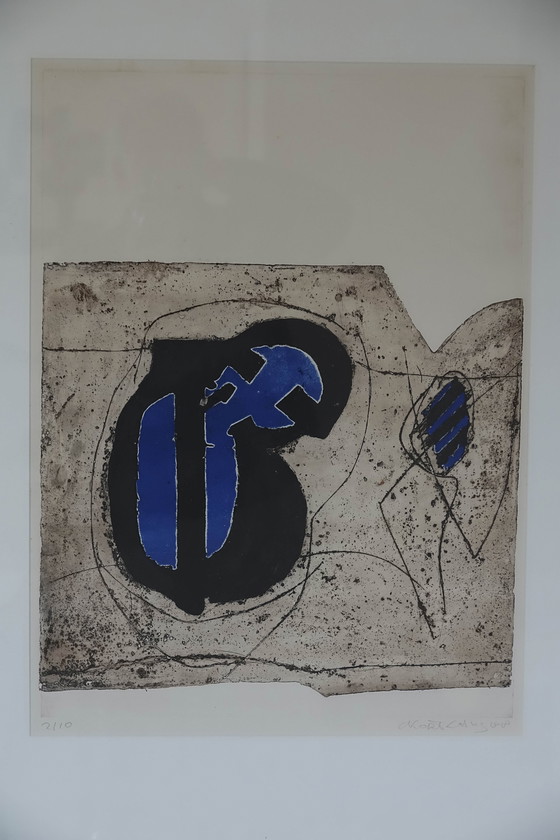Have it delivered hassle-freeBuyer protectionAll items curated by WhoppahDownload the Whoppah app here

Item not as advertised, money backAll items are curated and 100% authenticHave it delivered hassle-free or pick it up yourselfShop only from Trusted Sellers
Jan Smit
Product description
Beautiful etching by Cees Kortlang from 1988
Description
Beautiful work by the well known artist Cees Kortlang (1926-2008). Beautiful large work in a very small edition of 10. Beautiful light wooden frame. The work is in good condition, can be placed on the wall.
About the artist:
"Youth and Education.
Cees Kortlang was born in 1926 in Harderwijk as the eldest son in a family of three children and grew up in Ermelo. After completing HBS, he attended the Royal Academy of Art in The Hague from 1946-1952, where his major was drawing. He took exams but did not pass. Through Theo Swagemakers, Cees Kortlang and his then wife were able to move into a studio apartment on Zomerdijkstraat in Amsterdam's Rivierenbuurt neighborhood. Other residents of Zomerdijkstraat included Jan Wolkers, Piet Esser, Jaap Hillenius, Mies Hillenius, Theo Swagemakers and Jaap Wagemaker. With neighbor Jaap Wagemaker, Cees Kortlang had good contact; they drank coffee together every morning and shared a cigar.
Work
Cees Kortlang made paintings, etchings and gouaches. Later he also wrote several books, including the autobiographical book "Balans. Initially Kortlang worked figuratively, but in 1958 he switched to making abstract work. In the 1960s, in addition to making paintings, he began producing etchings. Kortlang's earliest known etchings date from 1960. Initially, he worked in black. After some tentative experimentation with color, from 1966 color made a definitive breakthrough in his oeuvre. This was related to his stay at the Graphic Workshop in Wolfsburg Castle. Every year he returned there to work for several weeks.
Workplaces
For a long time, Cees Kortlang lived and worked in the studio apartments on Zomerdijkstraat in Amsterdam, surrounded by other artists. But he was also frequently abroad. He and Jaap Wagemaker and Theo Swagemakers, among others, spent a short time in Prague in the early 1960s at the invitation of the government of Czechoslovakia. Starting in the mid-1960s, he spent several weeks each year at the Druckwerkstatt graphic studio at Wolfsburg Castle in Germany, which had been founded in 1962 by Gustav Kurt Beck. He also received a scholarship from the French government to work for a time at Stanley William Hayter's Atelier 17 in Paris in 1965. During the summers of 1976 and 1977, he worked at the Print Shop in St. Michaels, New Foundland. He also made trips to Prague, Iceland, Greenland and Ireland. The nature he saw in these countries inspired him and is reflected in his work.
Exhibitions and awards
In 1954, Kortlang had his first solo exhibition at hotel 'Zeezicht' in Harderwijk. At this time he made exclusively figurative work. Newspaper reports on the exhibition spoke highly of expressive portraits and characteristic interiors and harbor views. Other exhibitions followed, including in 1955 at the Museum of Art and History on the Loolaan in Apeldoorn. The Volkskrant of September 9, 1955, stated that much should be expected of the artist. He is characterized as a hard worker who is aware that he must toil to build a good reputation. Kortlang also exhibited at the Stedelijk Museum in Amsterdam during the exhibition Liga Nieuw Beelden (1961) and the Lucas exhibitions of 1959 and 1960. He participated in 1959 with the works "Composition City" and "Still Life with Fish" and in 1960 with "Landscape," "City at Night" and "Composition Landscape. Although Kortlang was now making abstract work, he participated in the exhibition with figurative work. There are now twenty works by his hand in the collection of the Stedelijk Museum Amsterdam.
The exhibitions kept coming and Cees Kortlang exhibited at home and abroad, including at Galerie De Drie Hendricken in Amsterdam, Galerie Frederic in Amsterdam, Galerie Horn in Luxembourg, Galerie de Luxembourg in Luxembourg and at the Schloss Wolfsburg in Wolfsburg. In 1963/1964, Cees Kortlang won the Talens Prize with his work Malá Strana. The jury called the work "gooder, more accomplished and as a result happier" than that of the competition.
Great loss
In 1992, after the death of his mother and the divorce of his wife, Kortlang moved back into his parents' home in Ermelo. By now, his daughter had grown up. During a May 1997 vacation in Venezuala, Karin Kortlang went missing with her boyfriend. This event marked a low point in Cees Kortlang's life. He incorporated the event in his 1997 etchings. Thus he made etchings with the titles ' Karin I love you', 'Their fall', 'Last resting place of Karin' and 'Where they are now'. Later, he also wrote about his daughter in the book Balans, an autobiographical account of his life's journey. The Karin Kortlang Foundation is named after his daughter. On April 5, 2008, Cees Kortlang died in Harderwijk from the effects of a cerebral hemorrhage." Source: Kortlang Foundation
Work is in good condition and nicely framed in light frame
Work is in good condition and nicely framed in light frame
Specifications
ConditionGoodColorsBlue, White, BlackMaterialWood, Paper, GlassNumber of items1OrientationPortraitArt sizeMediumHeight93 cmWidth73 cm






